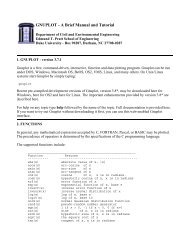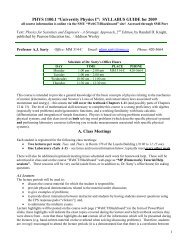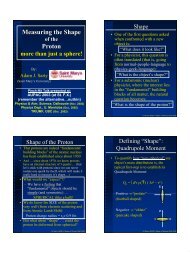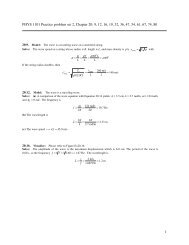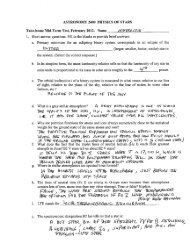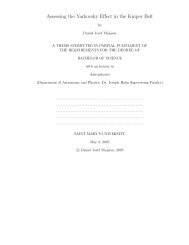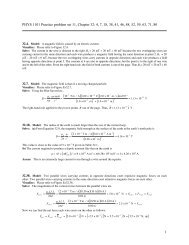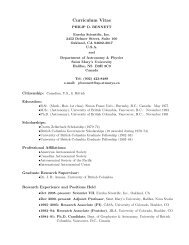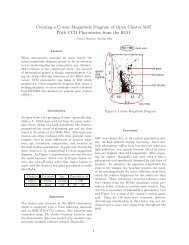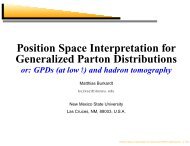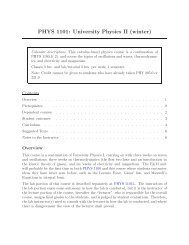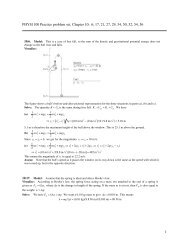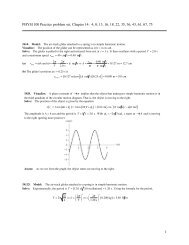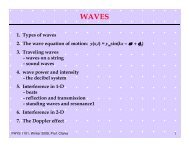PHYS 2301: Analytical Mechanics (winter)
PHYS 2301: Analytical Mechanics (winter)
PHYS 2301: Analytical Mechanics (winter)
- No tags were found...
Create successful ePaper yourself
Turn your PDF publications into a flip-book with our unique Google optimized e-Paper software.
<strong>PHYS</strong> <strong>2301</strong>: <strong>Analytical</strong> <strong>Mechanics</strong> (<strong>winter</strong>)Calendar description: This course continues on some of the ideas introduced in<strong>PHYS</strong> 2300.1(.2), and introduces the student to a broad range of other areasin classical mechanics. Topics include coupled and 3-D oscillators, non-inertialreference frames, central forces (celestial mechanics), N-body dynamics, rigidbodies, angular momentum and torques, deformation and vibration of beams.Note: Credit cannot be given to students who already have a credit for <strong>PHYS</strong>2305.1(.2), Newtonian <strong>Mechanics</strong>.ContentsOverview . . . . . . . . . . . . . . . . . . . . . . . . . . . . . . . . . . 1Prerequisites . . . . . . . . . . . . . . . . . . . . . . . . . . . . . . . . . 1Dependent courses . . . . . . . . . . . . . . . . . . . . . . . . . . . . . . 2Student outcomes . . . . . . . . . . . . . . . . . . . . . . . . . . . . . . 2Curriculum . . . . . . . . . . . . . . . . . . . . . . . . . . . . . . . . . 3Suggested Texts . . . . . . . . . . . . . . . . . . . . . . . . . . . . . . . 4Notes to the Instructor . . . . . . . . . . . . . . . . . . . . . . . . . . . . 4OverviewThis course essentially repeats the topics covered in <strong>PHYS</strong> 1100, but at a much more sophisticatedlevel. This is the penultimate course in <strong>Mechanics</strong>, in which everything is stilldiscussed in terms of Newton’s laws of motion rather than the Euler-Lagrange formalismreserved for <strong>PHYS</strong> 3300, Classical <strong>Mechanics</strong>; the ultimate course in this series.There is no lab portion to this course.PrerequisitesMATH <strong>2301</strong> (or 2320) Linear AlgebraMATH 2311 Intermediate Calculus IIStudents entering <strong>PHYS</strong> <strong>2301</strong> are expected to have mastered vector algebra includingthe dot and cross products, and to have had a good introduction to the algebra of series,Taylor and binomial expansions, partial derivatives, line, surface, and volume integrals,the theorems of Gauss, Green, and Stokes, vector spaces, matrices, determinants, systemsof linear equations, Dirac notation, and eigenalgebra. Concurrent to this course, students
2 Physics <strong>2301</strong>should be enrolled in MATH 2303 (Differential equations) and soon into the term shouldbe familiar with simple first and second order ODEs with constant coefficients.<strong>PHYS</strong> 2300 Vibrations, Waves, and OpticsThis course gives an thorough introduction to the wave equation citing many examples ofwaves in nature. Forced, damped simple harmonic oscillators (spring and LRC circuits)are also covered.Dependent courses<strong>PHYS</strong> 3300 Classical <strong>Mechanics</strong><strong>PHYS</strong> 3300 begins with the calculus of variations, derives the Euler-Lagrange equations,and then launches into the Lagrangian and Hamiltonian formulations of mechanics.Thus, many of the same ideas and problems taught in <strong>PHYS</strong> <strong>2301</strong> are revisited in<strong>PHYS</strong> 3300. Therefore, the instructor of <strong>PHYS</strong> 3300 relies much more heavily on theenhanced problem-solving skills of a student completing <strong>PHYS</strong> <strong>2301</strong> than any conceptsin physics covered, such as the conservation of energy, momentum, and Newton’s lawswhich were essentially covered in <strong>PHYS</strong> 1100 (University Physics I) anyway.Student OutcomesThe overall aim of the Classical <strong>Mechanics</strong> stream (300) is to develop the student into asolver of dynamic problems, and to build the student’s physical intuition into a reliable toolthat can be applied to any physical problem.Students completing <strong>PHYS</strong> <strong>2301</strong> should have developed the following skills:1. understand what constitutes a “well-posed” problem;2. break up a well-posed problem into its mathematical components;3. understand what constitutes a “system”, and how to define it;4. apply and be aware of simplifications;5. how and where to apply specific math skills;6. be able to exploit the symmetry of a problemTypical problems students completing <strong>PHYS</strong> <strong>2301</strong> should be able to solve:1. A billiard ball is struck by a horizontal cue with “top English” (half way between itstop and centre). What is its final speed in terms of the initial speed immediately afterimpact?
<strong>Analytical</strong> <strong>Mechanics</strong> 32. What are the natural frequencies of vibration of three masses coupled together by twosprings confined to move in one dimension?3. Show that a hurricane must spin counter-clockwise in the northern hemisphere (asviewed from above), and clockwise in the southern hemisphere.4. How much precession of Mercury’s orbit can be accounted for by Jupiter?5. If a rigid beam is struck by a hammer, how quickly does the wave propagate down thebeam?Curriculum1. Newtonian mechanics review- Free body diagrams- constrained motion2. coupled oscillators- normal coordinates/normal modes (eigenvalue/eigenvector approach)- normal modes of N coupled objects in 1-D, as N → ∞3. 3-D oscillators- non-linear oscillator (pendulum and elliptical integrals)- isochronus problem- spherical pendulum4. non-inertial reference frames- centrifugal and Coriolis forces5. central forces (celestial mechanics)- orbits, eccentricity- Kepler’s laws6. N-body dynamics- scattering- collisions in 2-D7. rigid bodies- tensor formulation for moment of inertia- deformation, bending- vibrating beams
4 Physics <strong>2301</strong>Suggested texts<strong>Analytical</strong> <strong>Mechanics</strong> (6th ed.) by Fowles (ISBN)- a classic for this subject at this level, used at SMU for some time and still a goodchoice for the revised curriculum- no vector calculus requiredFirst half of Classical Dynamics by Thornton and Marion (ISBN 0 5344 0896 6)- 2.5/5 stars (44 reviews) on amazon.com- second half may serve for <strong>PHYS</strong> 3300- suitable level for second year, but may be a little too light for third yearNotes to the instructor1. Students will have a background in matrices (MATH <strong>2301</strong>/2320) but not tensors.Indeed, no where else in the curriculum are tensors taught, and thus a short unit ontensor analysis in this course would be both appropriate and needed.2. The most important outcomes of this course are problem-solving skills and the cleveruse of symmetry and mathematics to solve problems of classical dynamics. This willbe tested most rigorously by problems in the rigid body unit outlined in the curriculumsection.3. Unlike <strong>PHYS</strong> 2300 (Vibrations, Waves and Optics), there are no labs or math courseswith which to coordinate the lectures. However, a discussion with the instructor of<strong>PHYS</strong> 3600 (Experimental Physics I) to determine what if any labs in classical dynamicswill be performed by students next year would allow you to foreshadow thesein your lectures, and perhaps use components of these labs as demonstrations.



